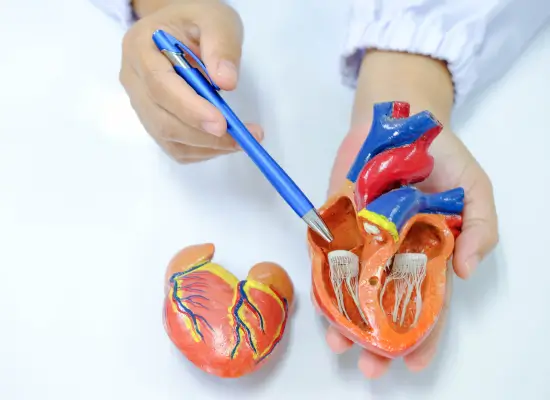CABG is performed under general anaesthesia, which means patients don’t stay awake during the procedure. However, after waking up, they might feel some discomfort as their bodies heal.

Synopsis
Coronary Artery Bypass Grafting (CABG) is a procedure to restore blood flow to the heart by bypassing blocked coronary arteries. Heart specialists use healthy blood vessels from the leg, arm, or chest to create a new pathway for blood. It improves heart function, reduces chest pain, and prevents heart attacks.
CABG (Coronary artery bypass grafting) is a surgical procedure that restores blood flow to the heart when there is a blockage in the arteries. It is also one of the most effective treatments for severe heart disease, which significantly reduces symptoms like chest pain and lowers the risk of heart attacks.
It was earlier considered a risky procedure for patients with long-term effects of coronary artery disease - left ventricular dysfunction and heart failure. As an open heart surgery procedure, CABG requires specialized care and a structured recovery plan. It is considered the best treatment plan for patients suffering from advanced cardiovascular conditions.
Hospitals like Gleneagles offer advanced technologies that help patients have an easy life.
What Is Coronary Artery Bypass Graft Surgery?
Coronary artery bypass grafting surgery, also known as heart bypass surgery, is a procedure designed to treat coronary artery disease. This condition arises from the constriction of the coronary arteries - the artery responsible for supplying oxygen and nutrients to the heart muscle. It involves rerouting blood flow around the blocked or narrowed coronary arteries, improving overall heart function.
CABG surgery in Mumbai involves taking a healthy blood vessel connected below the blocked heart artery. This ensures better blood flow to the heart muscle. Heart bypass surgery in Mumbai cures heart diseases that cause blockages to the blood flow, such as - atherosclerosis of coronary heart disease. Also, it reduces certain symptoms, such as - chest pain and shortness of breath.
Types Of CABG Procedure
- Single Bypass Surgery: Single bypass surgery uses a graft to bypass one blocked coronary artery and create a new pathway to restore blood flow to the heart muscle. It is mostly recommended for severe narrowing in a single coronary artery and for improving blood flow to the affected region of the heart. It enhances overall heart function and prevents further damage to the heart muscle.
- CABG X2 (Double Bypass Surgery): Redirecting blood flow around two blocked coronary arteries is known as double bypass heart surgery. To bypass the blockage and restore blood flow, an artery from another part of the body is grafted onto the heart. It is necessary in case of severe angina or if the ailment is not responsive to other treatments.
- CABG X3 (Triple Bypass Surgery): Triple bypass surgery addresses creating new pathways using blood vessels from other body parts to bypass multiple blocked coronary arteries. This helps in restoring blood flow to the heart muscle. This is done in case of CAD (severe coronary artery disease), which helps improve blood flow to the heart muscle and prevent further complications.
- CABG X4 (Quadruple Bypass Surgery): CABG X4, also known as quadruple bypass surgery, is done to address severe coronary artery disease by creating multiple bypass grafts to reroute blood around extensive blockages in the coronary arteries. It helps revascularize the heart when multiple coronary arteries are present, which ensures optimal blood flow and cardiac function.

Why Choose CABG Surgery In Mumbai?
CABG surgery in Mumbai is opted for due to several benefits it offers. It helps improve the quality of life and long-term survival rates for patients with severe coronary artery disease. It is done to help people suffering from the following conditions:
- Severe symptoms of angina
- Failed angioplasty or stent placement
- Severe blockages in the coronary artery
- Significant left main coronary artery disease
Bypass heart surgery procedure offers several benefits such as -
- Relief From Symptoms: People with severe coronary artery disease experience symptoms such as - chest pain, angina, shortness of breath, and fatigue. Following the surgery, many patients experience relief from such symptoms. Also, they have reported improving their physical activities and enjoying an active lifestyle.
- Improved Blood Flow And Oxygen Supply: CABG surgery restores blood circulation by bypassing blocked arteries. Thus ensuring the heart receives proper oxygen and nutrients. This reduces the strain on the heart and prevents any further complications. Thus helping the heart function properly and efficiently. Proper blood flow enhances overall heart health and helps people engage in their daily lives easily.
- Lower Risk Of Heart Attack: CABG includes rerouting the blood around clogged arteries, which reduces the likelihood of heart attacks, which may be caused by restricted blood flow. After the procedure, the vital heart muscle starts receiving proper oxygen supply, preventing tissue damage. This provides patients with long-term, healthy, and stable hearts - reducing the chances of any life-threatening diseases.
- Reduced Need For Repeated Medical Interventions: CABG is effective for severe coronary artery conditions. Thus minimizing the need for repeated medical interventions such as - stent placements or angioplasty. It addresses multiple complications at once and offers a long time relief from any discomfort.
Your health matters – get expert advice today.
Preparation For CABG
To prepare for a CABG surgery in Mumbai, doctors may ask to change the patient’s lifestyle, diet, and medications. Also, having someone who can drive the patient home after the surgery is advisable.
CABG Procedure Steps:
1. Before The Procedure: Before the procedure, the best CABG surgeons in Mumbai ask to arrive early at the hospital for the tests and monitoring procedure. Testing and monitoring is one of the first and foremost CABG procedure steps.
2. During The Procedure: Coronary artery bypass graft is a major surgery that requires hospitalisation. Cardiovascular surgeons do the surgery, along with a team of cardiologists and other healthcare professionals who assist them in the surgery. Before entering the operating room, an IV is inserted into the forearm or hand, and a sedative is given to help the patient relax.
The operating room has a breathing machine with a tube attached to it. The tube is inserted into the patient’s mouth, which breathes for them during and immediately after the surgery. Also, the OT uses a lung machine that keeps blood and oxygen flowing through the body during the procedure. This is known as on-pump coronary bypass.
The CABG procedure takes around 3-6 hours - depending on the complexity of the condition and the patient’s health. Here’s what happens during the surgery:
- Patients are usually put under general anesthesia.
- A long cut is made to open the chest, which makes the heart accessible, by cutting through the breastbone.
- The heart is temporarily stopped with medicine, and the patient is kept on the lung machine.
- A healthy blood vessel is taken from the leg, arm, and chest to create a bypass. This piece of healthy tissue is known as a graft.
- The graft is attached below the blocked heart artery to create a new path for blood to flow around a blockage.
- After the procedure, the heartbeat is restored, and the surgeon uses a wire to close the chest bone, which stays in the body after the wound heals.
3. After The Procedure: After the coronary artery bypass graft, patients may feel sore and confused - this is due to anesthesia. The patient is kept under observation for a few days to check and monitor any complications that may arise. Medications such as pain relief are given to combat any pain. Also, patients have to undergo cardiac rehab, which helps improve their heart health after surgery.
After 2-3 days of observation, the hospital discharges the patient. After a few days, they may experience - fever, pain around the chest, change in skin color, bleeding or discharge, rapid heart rate, etc. In any such cases - it is advisable to seek immediate medical assistance.
Recovery And Aftercare
After recovering from coronary artery bypass surgery, most people feel better, while some experience symptoms for several years. In some cases, the graft may become clogged, which may require another surgery. Doctors may suggest the patients:
- Sleep well
- Quit smoking
- Manage stress
- Manage weight
- Eat healthy foods
- Exercise and stay active
Risks And Complications After CABG
Here are some risks and complications after CABG in Mumbai:
- Stroke
- Kidney dysfunction or failure
- Bleeding during or after surgery
- Irregular heart rhythms (arrhythmias)
- Breathing difficulties or lung infections
- Infection at the incision site or in the chest
- Poor wound healing, especially in diabetic patients
- Memory problems or difficulty concentrating (postoperative cognitive dysfunction)
To manage the complications post-surgery, doctors usually prescribe certain medications, such as blood thinners, to prevent and avoid blood clots.
Difference Between Bypass And Open Heart Surgery
Here is a table that showcase the difference between bypass and open heart surgery:
| Feature | Bypass Surgery | Open Heart Surgery |
| Purpose | To create new pathways for blood to flow around blocked arteries in the heart. | A broader term encompassing various procedures to repair or replace heart valves, correct congenital defects, or transplant a heart. |
| Procedure | Involves grafting a healthy blood vessel from another part of the body to bypass the blocked artery. | Requires opening the chest and accessing the heart directly to perform the necessary repairs or replacements. |
| Heart-Lung Machine | May or may not be used. | Typically requires the use of a heart-lung machine to temporarily take over the heart's function. |
| Incision | Smaller incisions may be used in minimally invasive procedures. | Requires a larger incision in the chest to access the heart. |
| Recovery | Generally shorter recovery time compared to other open-heart procedures. | Recovery time varies depending on the specific procedure performed. |
Why Choose Gleneagles Hospitals For CABG In Mumbai?
Gleneagles Hospitals is a leading healthcare facility for heart operation in Mumbai. We offer expert care using advanced technology and a patient-centered approach. Our center of excellence for cardiology, cardiothoracic and Vascular Surgery offers comprehensive and innovative treatments using evidence-based practices.
We care about your heart! Contact Gleneagles Hospitals to book an appointment!
Our Doctors
View allFrequently Asked Questions
The cost of CABG surgery in Mumbai usually ranges from INR 250,000 to INR 500,000 - depending on the hospital, the expertise of the doctor, the patient’s medical condition, etc. The price may or may not include the diagnostic tests.
Yes. With the advancement of modern technology, world-class medical hospitals, and highly best CABG surgeons in Mumbai, CBAG is one of the safest procedures. However, it may carry some risks.
Initial hospital recovery takes about 7-10 days, while a full recovery period may range from 6 to 12 weeks.
Grafts usually last for 10-15 years. However, certain factors, such as lifestyle, diet, exercise, medical adherence, etc., also determine the longevity of the graft.














